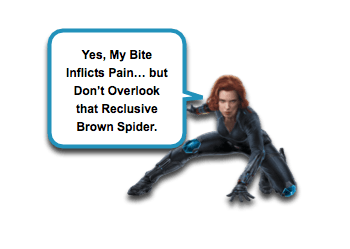Brown Recluse Spider Envenomation
 Children are curious creatures. Yes, they are perplexing (well, at least my kids are), but they are also interested in exploring their environments. This curiosity can place them in harms way at times… and then they come to see you in the ED. At times, these environmental hazards are human-made (ex, Firearms, Laundry Detergent Pods, Button Batteries, Fish hooks, Liquid Nicotine, Trampolines) and other times they are related to Mother Nature (ex, Cold Exposure, Vehicular Heat Exposure, Submersions). Still, it is often the creepy crawling pests that grab people’s attention (ex, RMSF, Lyme, Lice, Scabies). Certainly, the Black Widow has gained much notoriety (both the Marvels version and the arachnid), but let us not forget the shier spider, which can cause problems for our little patients. Let’s take a minute to review the Brown Recluse Envenomations:
Children are curious creatures. Yes, they are perplexing (well, at least my kids are), but they are also interested in exploring their environments. This curiosity can place them in harms way at times… and then they come to see you in the ED. At times, these environmental hazards are human-made (ex, Firearms, Laundry Detergent Pods, Button Batteries, Fish hooks, Liquid Nicotine, Trampolines) and other times they are related to Mother Nature (ex, Cold Exposure, Vehicular Heat Exposure, Submersions). Still, it is often the creepy crawling pests that grab people’s attention (ex, RMSF, Lyme, Lice, Scabies). Certainly, the Black Widow has gained much notoriety (both the Marvels version and the arachnid), but let us not forget the shier spider, which can cause problems for our little patients. Let’s take a minute to review the Brown Recluse Envenomations:
Brown Recluse Spider: Basics
- Brown Recluse Spider = Loxosceles reclusa
- Tan or brown in color
- Has a “violin-shaped” marking in darker brown on its back.
- Has 6 eyes (2 set of 3 in a semi-circular row), while other spiders have 8 eyes (honestly, I’m not getting close enough to count the eyes!)
- Commonly found in the Southern and Midwestern United States as well as worldwide.
- Most cases occur in Arkansas, Kansas, Missouri, and Tennessee. [Elbahlawan, 2005]
- Not found in the Pacific Northwest (yeah, Oregon!).
- In South America is it responsible for considerable morbidity. [Isbister, 2003]
- Rarely seen:
- They are, after all, reclusive…
- They hang out in dark, undisturbed areas (woodpiles, under houses, in basements, gardening gloves, etc).
- It’s bite is painless – so even if bitten by one, you may not recognize the spider.
- One of a few spiders that not only bite humans, but whose venom may cause serious wounds and poisoning. [See Poison Control]
Brown Recluse Spider: Toxicity
- Brown Recluse venom can destroy human tissue.
- Envenomation:
- Local Effects: [Hubbard, 2011; Elbahlawan, 2005]
- Pain, Inflammation, and Skin Necrosis
- Often called “Necrotic Arachnidism“
- Initial bite appears like any other insect bite (small area of inflammation).
- Central blister can develop in the first 12-24 hrs.
- Over several days, tissue destruction occurs.
- Wound develops and enlarges.
- Wound becomes painful and noticeable.
- Necrosis of the central region occurs.
- Can appear like Pyoderma Gangrenosum.
- May heal with crater-like scar.
- Systemic Effects: (~1% of cases) [Hubbard, 2011; Elbahlawan, 2005]
- Venom can penetrate deeper structures (Sub Q tissue, fat, muscle).
- Systemic venom effects = “loxoscelism“
- Brown Recluse Venom can directly cause hemolysis of red cells. [Hubbard, 2011]
- Severity is based upon dose of venom.
- Systemic effects include:
- Arthralgias
- Fevers and Chills
- Leukocytosis
- Maculopapular Rash
- Hemolytic Anemia [Hubbard, 2011; Elbahlawan, 2005]
- Can have early and late hemolysis
- Most common complication.
- Disseminated Intravascular Coagulation
- Hemoglobinuria
- Myoglobinuria
- Acute Renal Failure
- Death – very rare
- Wound can become super-infected and infection can spread.
- Then we can have good old fashioned Sepsis and SHOCK.
- Venom can penetrate deeper structures (Sub Q tissue, fat, muscle).
- Local Effects: [Hubbard, 2011; Elbahlawan, 2005]
Brown Recluse Spider: Management
- The diagnosis is often made presumptively: [Elbahlawan, 2005]
- Spider usually not found/ noticed/ captured
- Symptoms are delayed by days
- Diagnosis often based on potential exposure, wound appearance, and progression of effects.
- Educate those with Local Findings! [Hubbard, 2011]
- If there is only local findings, give anticipatory guidance that can help identify the rare case that develops systemic complications.
- Have family / guardians monitor for:
- Fatigue and / or anorexia
- Darkening of urine
- Decreased urine output
- Consider Complications! [Hubbard, 2011]
- Check Urinalysis
- Check CBC and reticulocyte counts
- Check Serum CPK
- Check Renal Function
- Supportive Care is the Main Therapy! [Hubbard, 2011]
- Antihistamines
- Tetanus prophylaxis
- Surgical excision / debridement of necrotic tissue
- Antibiotics for super-infection
- Steroids, dapsone, antivenoms and Hyperbaric oxygen therapies have not been proven to be effective. [Elbahlawan, 2005]
- Antivenoms may not be helpful because the lesion is detected too late to have the antivenom be effective (>24 hours). [Isbister, 2003]
Moral of the Morsel
- Reclusive beasts hurt little people! Children are more apt to have systemic toxicity than adults from the Brown Recluse bite.
- Odd escar? Think of the Brown Recluse!
- Check that urine! Treat symptomatically, but look for systemic complications!


What are the available home remedy methods to ease pain in case of Brown Recluse Spider Envenomation.